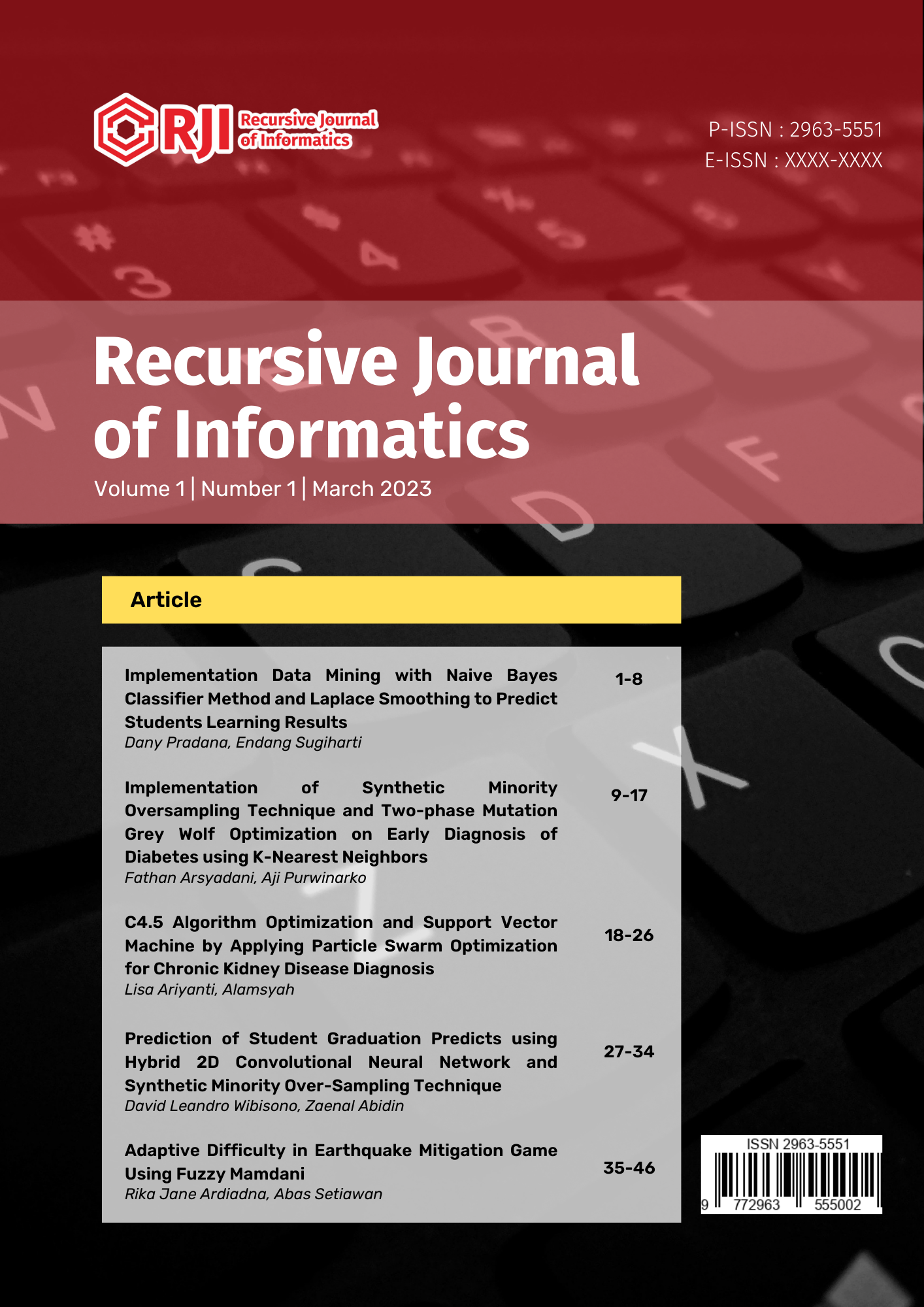Implementation Data Mining with Naive Bayes Classifier Method and Laplace Smoothing to Predict Students Learning Results
Abstract
Abstract. The application of information technology in the field of education produces big data. It retains information that can be treated as useful. Having data mining, can be used to model highly useful student performance for educators performing corrective actions against weak students.
Purpose: The study was to identify the application and accuracy algorithm Naive Bayes Classifier to predict students' study results.
Methods: The prediction system for student learning outcomes was built using the Naive Bayes Classifier and Laplace Smoothing methods using a combination of two Information Gain and Chi Square feature selections. The experiment was carried out 2 times using different dataset comparisons.
Result: In the first experiment using a dataset of 80:20, the accuracy Naive Bayes Classifier method with Laplace Smoothing and without Laplace Smoothing showed the same results as 94.937%. On the second experiment to equate dataset 60:40 results of the Naive Bayes Classifier accurate method without Laplace Smoothing only 86.076%, then score a 91.772% accuracy using the Laplace Smoothing. The improvement is caused by a probability of zero that can be worked out with Laplace Smoothing.
Novelty: The selection feature process is very important in the classification process. Thus, in this study, information gain and chi square double selections of such features as information gain and so promote accuracy.
References
[2] M. Husaini, “Pemanfaatan Teknologi Informasi dalam Audit Investigatif,” Jurnal Mikrotik, vol. 2, no. 1, pp. 141–147, 2014.
[3] R. A. Maharani and I. N. Aini, “Deskripsi Tahapan Problem Solving Siswa Pada Soal Bertipe Pisa Space and Shape Content,” Jurnal Cendekia : Jurnal Pendidikan Matematika, vol. 5, no. 2, pp. 1193–1200, May 2021, doi: 10.31004/cendekia.v5i2.608.
[4] L. Lewi and M. Shaleh, “Assesment): Upaya Perbaikan Bertumpu Pada Pendidikan Anak Usia Dini,” Jurnal Golden Age, Universitas Hamzanwadi, vol. 4, no. 1, 2020.
[5] M. Sattarian, J. Rezazadeh, R. Farahbakhsh, and A. Bagheri, “Indoor navigation systems based on data mining techniques in internet of things: a survey,” Wireless Networks, vol. 25, no. 3, pp. 1385–1402, Apr. 2019, doi: 10.1007/s11276-018-1766-4.
[6] I. Mahendra, I. Suta, and M. Sudarma, “Classification of Data Mining with Adaboost Method in Determining Credit Providing for Customers,” IJEET Int. J. Eng. Emerg. Technol, vol. 4, no. 1, pp. 31–36, 2019.
[7] A. Yasar and M. M. Saritas, “Performance Analysis of ANN and Naive Bayes Classification Algorithm for Data Classification,” International Journal of Intelligent Systems and Applications in Engineering, vol. 7, no. 2, pp. 88–91, Jan. 2019, doi: 10.18201/ijisae.2019252786.
[8] P. Valdiviezo-Diaz, F. Ortega, E. Cobos, and R. Lara-Cabrera, “A Collaborative Filtering Approach Based on Naïve Bayes Classifier,” IEEE Access, vol. 7, pp. 108581–108592, 2019, doi: 10.1109/ACCESS.2019.2933048.
[9] I. A. Musdar, “Aplikasi Prediksi Kerusakan Smartphone Menggunakan Metode Naive Bayes dan Laplace Smoothing,” Jtriste, vol. 5, no. 2, pp. 8–16, 2018.
[10] Y. Angraini, S. Fauziah, and J. L. Putra, “Analisis Kinerja Algoritma C4.5 dan Naïve Bayes dalam Memprediksi Keberhasilan Sekolah Menghadapi UN,” JITK (Jurnal Ilmu Pengetahuan dan Teknologi Komputer), vol. 5, no. 2, pp. 285–290, Feb. 2020, doi: 10.33480/jitk.v5i2.1233.
[11] I. Listiowarni and E. Rahayu Setyaningsih, “Analisis Kinerja Smoothing pada Naive Bayes untuk Pengkategorian Soal Ujian,” Jurnal Teknologi dan Manajemen Informatika, vol. 4, no. 2, Jun. 2018, doi: 10.26905/jtmi.v4i2.2080.
[12] D. Novianti, “Implementasi Algoritma Naïve Bayes Pada Data Set Hepatitis Menggunakan Rapid Miner,” Paradigma - Jurnal Komputer dan Informatika, vol. 21, no. 1, pp. 49–54, Mar. 2019, doi: 10.31294/p.v21i1.4979.
[13] E. Siswanto, “Optimasi Metode Naïve Bayes Dalam Memprediksi Tingkat Kelulusan Mahasiswa Stekom Semarang,” JURIKOM (Jurnal Riset Komputer), vol. 6, no. 1, pp. 1–6, 2019.
[14] I. S. Ahmad, A. A. Bakar, and M. R. Yaakub, “A review of feature selection in sentiment analysis using information gain and domain specific ontology,” International Journal of Advanced Computer Research, vol. 9, no. 44, pp. 283–292, Sep. 2019, doi: 10.19101/IJACR.PID90.
[15] Kurniabudi, D. Stiawan, Darmawijoyo, M. Y. Bin Idris, A. M. Bamhdi, and R. Budiarto, “CICIDS-2017 Dataset Feature Analysis With Information Gain for Anomaly Detection,” IEEE Access, vol. 8, pp. 132911–132921, 2020, doi: 10.1109/ACCESS.2020.3009843.
[16] M. C. Wijanto, “Sistem Pendeteksi Pengirim Tweet dengan Metode Klasifikasi Naive Bayes,” Jurnal Teknik Informatika dan Sistem Informasi, vol. 1, no. 2, Aug. 2015, doi: 10.28932/jutisi.v1i2.378.
[17] S. E. Prasetyo, P. H. Prastyo, and S. Arti, “A Cardiotocographic Classification using Feature Selection: A comparative Study,” JITCE (Journal of Information Technology and Computer Engineering), vol. 5, no. 01, pp. 25–32, Mar. 2021, doi: 10.25077/jitce.5.01.25-32.2021.
[18] G. Gustientiedina, M. Siddik, and Y. Deselinta, “Penerapan Naïve Bayes untuk Memprediksi Tingkat Kepuasan Mahasiswa Terhadap Pelayanan Akademis,” Jurnal Infomedia: Teknik Informatika, Multimedia & Jaringan, vol. 4, no. 2, pp. 89–93, 2019.
[19] Y.-C. Zhang and L. Sakhanenko, “The naive Bayes classifier for functional data,” Stat Probab Lett, vol. 152, pp. 137–146, Sep. 2019, doi: 10.1016/j.spl.2019.04.017.
[20] R. V. B. Vangara*, K. Thirupathur, and S. P. Vangara, “Opinion Mining Classification u sing Naive Bayes Algorithm,” International Journal of Innovative Technology and Exploring Engineering, vol. 9, no. 5, pp. 495–498, Mar. 2020, doi: 10.35940/ijitee.E2402.039520.
[21] I. Listiowarni, “Implementasi Naïve Bayessian dengan Laplacian Smoothing untuk Peminatan dan Lintas Minat Siswa SMAN 5 Pamekasan,” Jurnal Sisfokom (Sistem Informasi dan Komputer), vol. 8, no. 2, pp. 124–129, Aug. 2019, doi: 10.32736/sisfokom.v8i2.652.
[22] H. T. Sueno, “Multi-class Document Classification using Support Vector Machine (SVM) Based on Improved Naïve Bayes Vectorization Technique,” International Journal of Advanced Trends in Computer Science and Engineering, vol. 9, no. 3, pp. 3937–3944, Jun. 2020, doi: 10.30534/ijatcse/2020/216932020.
[23] Y. N. Ifriza and M. Sam’an, “Performance comparison of support vector machine and gaussian naive bayes classifier for youtube spam comment detection,” Journal of Soft Computing Exploration, vol. 2, no. 2, pp. 93–98, 2021, doi: 10.52465/joscex.v2i2.42.









